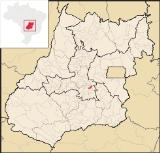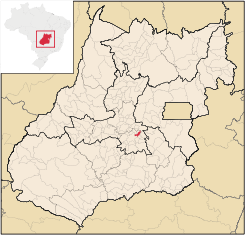
Goianápolis
Encyclopedia
| Goianápolis | |
|---|---|
| State | Goiás Goiás Goiás is a state of Brazil, located in the central part of the country. The name Goiás comes from the name of an indigenous community... |
| Area: | 162.3 km² |
| Population: | 11,159 (IBGE 2007) |
| Elevation: | 982 m above sea level |
| Postcode (CEP): | 75170-000 |
| Became a city: | 1958 |
| Distance to Goiânia Goiânia -Climate:The city has a tropical wet and dry climate with an average temperature of . There's a wet season, from October to April, and a dry one, from May to September. Annual rainfall is around 1,520 mm.... : |
27 km. |
| IBGE statistical microregion: | Goiânia Microregion Goiânia Microregion The Goiânia Microregion is a region in central Goiás state, Brazil. It includes 17 municipalities with a population of 2,032,305 in a total area of 6,848.00 km².... |
| Website: | none |

Town
A town is a human settlement larger than a village but smaller than a city. The size a settlement must be in order to be called a "town" varies considerably in different parts of the world, so that, for example, many American "small towns" seem to British people to be no more than villages, while...
and municipality
Municipality
A municipality is essentially an urban administrative division having corporate status and usually powers of self-government. It can also be used to mean the governing body of a municipality. A municipality is a general-purpose administrative subdivision, as opposed to a special-purpose district...
in central Goiás
Goiás
Goiás is a state of Brazil, located in the central part of the country. The name Goiás comes from the name of an indigenous community...
state, Brazil
Brazil
Brazil , officially the Federative Republic of Brazil , is the largest country in South America. It is the world's fifth largest country, both by geographical area and by population with over 192 million people...
. It had a population of 11,159 (IBGE 2007 estimate) in a total area of 162.38 km² (2007). The town is famous for its tomato production and as the birthplace of Leandro and Leonardo, one of the most famous country and western duos in recent Brazilian music.
Goianápolis, the so-called "state tomato capital", is located 33 km. northwest of the state capital of Goiânia and 11 km. south of the important Goiânia-Brasília highway. It belongs to the Goiânia Microregion
Goiânia Microregion
The Goiânia Microregion is a region in central Goiás state, Brazil. It includes 17 municipalities with a population of 2,032,305 in a total area of 6,848.00 km²....
. Connections with Goiânia
Goiânia
-Climate:The city has a tropical wet and dry climate with an average temperature of . There's a wet season, from October to April, and a dry one, from May to September. Annual rainfall is around 1,520 mm....
are made by BR-457 / GO-415.
It forms boundaries with Anápolis
Anápolis
Anápolis is the third largest city in the State of Goiás in Brazil. It lies in the center of a rich agricultural region and has become a leader in food processing and pharmaceutical plants.-Location and population:...
, Terezópolis de Goiás
Terezópolis de Goiás
Terezópolis de Goiás is a small town and municipality in central Goiás state, Brazil.-Location:Terezópolis is located in the Goiânia Microregion, 28 kilometers northeast of the capital, Goiânia...
, and Leopoldo de Bulhões
Leopoldo de Bulhões
Leopoldo de Bulhões is a small town and municipality in central Goiás state, Brazil. The total area was 495.0 km² in October 2002) and the population was 8,916 in 2007...
.
The climate is tropical humid. The hydrographic basin is formed by the streams of João Leite, Sozinha, Pindobal, Macaco, Arábia and da Gama. The water supply comes from the Ribeirão Sozinha.
Political Data
- Eligible voters: 8,717 (2007)
- Mayor: Waldecino Ferreira Neto
- Vice-mayor: Gary Rocha de Paula
- Councilmembers: 09
Demographic Data
- Population density: 68.72 inhab/km² (2007)
- Population growth rate 2000/2007: 0.64.%
- Population in 1980: 7,569 hab
- Population in 1991: 10,716
- Urban population in 2007: 10,109
- Rural population in 2007: 1,050
The economy
The main economic activity of the city was, until recently, the production of tomatoes (100 hectares in 2006), which were sold all over the country and even exported to Argentina and Paraguay. This activity has dropped off significantly in recent years.There is also production of rice, corn (400 hectares), beans, bananas, manioc, cabbage, carrots, and sugar beets. There were 15,000 head of cows in 2006.
Data are from IBGE
Economic Data
- Industrial units: 19 (06/2007)
- Retail units: 61 (08/2007)
- Banking institutions: BRADESCO S.A. (08/2007)
Education and Health
- Literacy rate: 84.3%
- Infant mortality rate: 33.94 in 1,000 live births
- Schools: 08 (2006)
- Classrooms: 54
- Teachers: 127
- Students: 3,094
- Hospitals: 01 (2007)
- Hospital beds: 35
History
The history of Goianápolis began when Pedro Ludovico Teixeira decided to transfer the capital of the state from Goiás to Goiânia in 1933. With the change, there was an increase in population from Anápolis to the region of Campininha where the new capital was being built. Families arrived in the region looking for land to plant and to raise pigs. Soon a new municipality was formed: Goianápolis—a combination of Goiânia and Anápolis.Goianápolis is also famous in Brazil as the birthplace of Leandro and Leonardo, one of the most famous country duos in Brazilian music. See official site at Leandro e Leonardo
Human Development Index
Human Development Index
The Human Development Index is a composite statistic used to rank countries by level of "human development" and separate "very high human development", "high human development", "medium human development", and "low human development" countries...
: 0.689
- State ranking: 217 (out of 242 municipalities in 2000)
- National ranking: 3,174 (out of 5,507 municipalities in 2007)
For the complete list see Frigoletto.com
Sources of Data
See also List of municipalities in Goiás

